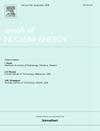Development of a two-phase flow solver with two-fluid model based on OpenFOAM: Validation against two-phase boiling flow
IF 1.9
3区 工程技术
Q1 NUCLEAR SCIENCE & TECHNOLOGY
引用次数: 0
Abstract
The continuous advancement in computer technology and mathematical-physical models has significantly propelled the development of numerical reactor technology. There is a growing focus on high-fidelity, multi-scale, and multi-physics coupling within a unified framework. OpenFOAM, based on the finite volume method, has emerged as a promising tool for addressing this challenge. This study explores its capabilities in system-level scales, successfully developing a two-fluid, six-equation solver. The realistic closure models cover flow and heat transfer scenarios within vertical channels under pre-CHF conditions. A virtual thermal structure accounts for conjugate heat transfer between the fluid and the solid. Furthermore, the solver adheres to the discretization and solution principles within the OpenFOAM framework. The developed solver has been extensively validated against experimental data for two-phase boiling flow, with results showing good agreement, thereby demonstrating the solver’s success. This work builds upon previous efforts involving the drift-flux solver and indicates that OpenFOAM can effectively handle one-dimensional or system-level scale calculations. It provides robust support for future endeavors in multi-scale and multi-physics coupling technologies.
基于OpenFOAM的双流体模型两相流求解器的开发:对两相沸腾流的验证
计算机技术和数学物理模型的不断进步有力地推动了数值反应堆技术的发展。在一个统一的框架内,人们越来越关注高保真度、多尺度和多物理场耦合。基于有限体积方法的OpenFOAM已经成为解决这一挑战的一个有前途的工具。本研究探索了其在系统级尺度上的能力,成功地开发了一个两流体,六方程求解器。实际封闭模型涵盖了预chf条件下垂直通道内的流动和换热情况。虚热结构解释了流体和固体之间的共轭传热。此外,求解器遵循OpenFOAM框架内的离散化和求解原则。所开发的求解器已与两相沸腾流的实验数据进行了广泛的验证,结果吻合良好,从而证明了求解器的成功。这项工作建立在先前涉及漂移通量求解器的工作基础上,表明OpenFOAM可以有效地处理一维或系统级规模计算。它为未来在多尺度和多物理场耦合技术方面的努力提供了强有力的支持。
本文章由计算机程序翻译,如有差异,请以英文原文为准。
求助全文
约1分钟内获得全文
求助全文
来源期刊

Annals of Nuclear Energy
工程技术-核科学技术
CiteScore
4.30
自引率
21.10%
发文量
632
审稿时长
7.3 months
期刊介绍:
Annals of Nuclear Energy provides an international medium for the communication of original research, ideas and developments in all areas of the field of nuclear energy science and technology. Its scope embraces nuclear fuel reserves, fuel cycles and cost, materials, processing, system and component technology (fission only), design and optimization, direct conversion of nuclear energy sources, environmental control, reactor physics, heat transfer and fluid dynamics, structural analysis, fuel management, future developments, nuclear fuel and safety, nuclear aerosol, neutron physics, computer technology (both software and hardware), risk assessment, radioactive waste disposal and reactor thermal hydraulics. Papers submitted to Annals need to demonstrate a clear link to nuclear power generation/nuclear engineering. Papers which deal with pure nuclear physics, pure health physics, imaging, or attenuation and shielding properties of concretes and various geological materials are not within the scope of the journal. Also, papers that deal with policy or economics are not within the scope of the journal.
 求助内容:
求助内容: 应助结果提醒方式:
应助结果提醒方式:


